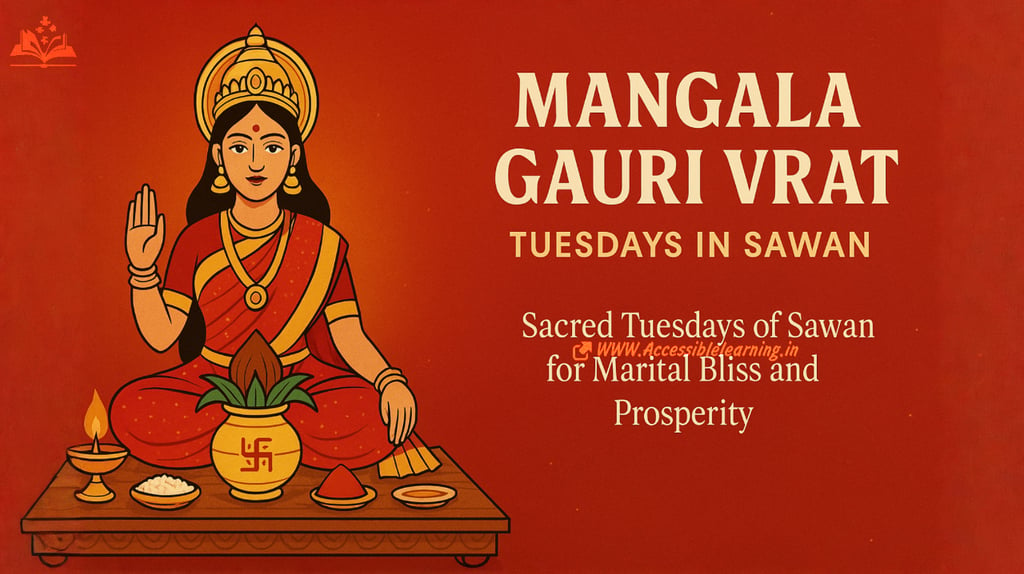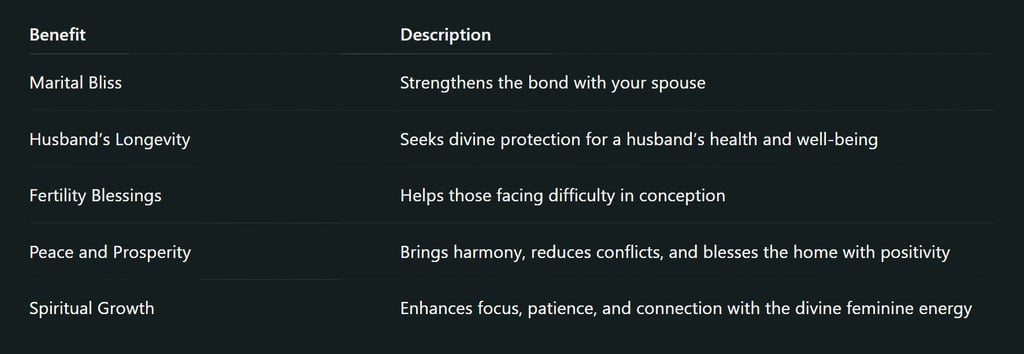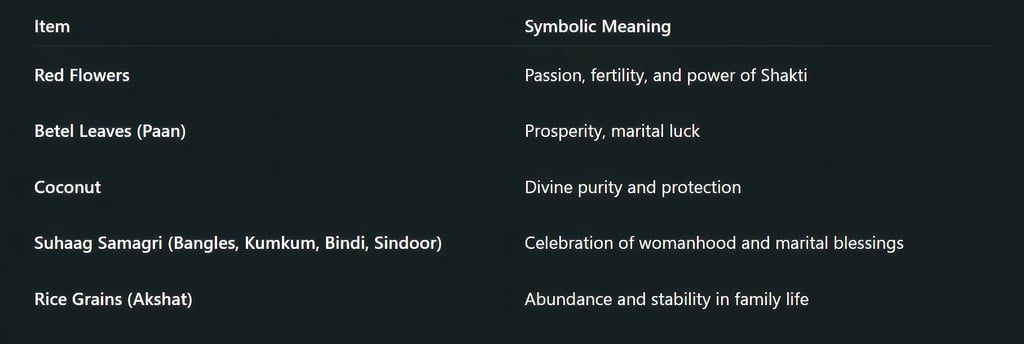
Mangala Gauri Vrat: Sacred Tuesdays of Sawan for Marital Bliss and Prosperity
Explore the sacred significance of Mangala Gauri Vrat, observed on Tuesdays during Sawan. Discover its rituals, legends, astrological benefits, and modern-day relevance. Perfect for women seeking spiritual growth, marital bliss, and divine blessings.
CULTURE/TRADITIONINDIA/BHARATCELEBRATION/FESTIVALS
Keshav Jha
7/8/20255 min read


Mangala Gauri Vrat is a deeply revered and spiritually enriching Hindu observance dedicated to Maa Parvati, observed by married women and unmarried girls seeking a blissful married life. It is held on Tuesdays during the sacred month of Sawan (Shravan)—a time when divine energies are believed to be most potent.
This vrat (fast) celebrates Gauri, another name for Maa Parvati, who is considered the epitome of devotion, strength, and marital virtue. Women worship her to gain blessings for marital harmony, family well-being, fertility, and spiritual growth.
Why Is Mangala Gauri Vrat Important?
Spiritual Upliftment: It fosters inner peace, patience, and devotion—virtues that strengthen relationships.
Marital Blessings: Ideal for married women praying for their husband’s longevity and happiness.
Ideal Match for Unmarried Girls: Young women observe it with hopes of getting a loving and caring life partner.
Family Prosperity: It is believed to remove obstacles related to finances, fertility, and peace in the home.
When Is Mangala Gauri Vrat Observed?
This vrat is observed on all Tuesdays of the Sawan month (usually July–August), particularly in North India and Maharashtra.
For example, in 2025, Mangala Gauri Vrat falls on
July 8
July 15
July 22
July 29
Mangala Gauri Vrat Vidhi (Rituals & Procedure)
Pre-Dawn Preparations
Wake up early (Brahma Muhurat) and take a bath.
Clean the puja space and set up a sacred mandap (altar).
Idol or Image of Goddess Gauri
Place an idol or picture of Mangala Gauri, decorated with flowers and red cloth.
Offerings (Naivedya & Samagri):
Red flowers, betel leaves, rice, kumkum, fruits, panchamrit, coconut, mangalsutra, and suhaag items.
Special dishes include puran poli, poha, kheer, and besan laddoo.
Fasting Rules
Some women observe a nirjala vrat (without water), while others opt for phalahar (fruits only) or light sattvik food post-sunset.
Puja & Aarti
Light a diya (oil lamp) and incense.
Recite Mangala Gauri Vrat Katha, perform aarti, and chant mantras like
"Om Hreem Gauri Pathivrataaye Namah"
Listening to Vrat Katha
The story involves Maa Parvati, Shiv Ji, and the spiritual power of devotion that changes one’s destiny.
Completing the Vrat
Offer dakshina and food to a Brahmin or a married woman.
Perform charity, if possible.
The Legend of Mangala Gauri Vrat
According to popular belief, once a woman named Suman performed this vrat with full devotion. As a result, Yama (the God of Death) could not take her husband’s life, and he was brought back to life. It is said that Maa Parvati herself appeared to bless her, making this vrat extremely powerful.
This myth highlights the power of love, dedication, and divine intervention through devotion.
Who Should Observe Mangala Gauri Vrat?
Newly Married Women: It's a tradition to observe the vrat for the first five years after marriage for a harmonious conjugal life.
Unmarried Girls: To attain a suitable life partner blessed with good health, values, and prosperity.
Women Seeking Family Well-being: For those praying for children or peace at home.




Astrological Significance of Mangala Gauri Vrat
Day Significance: Tuesday is governed by Mars (Mangal Graha), which rules energy, courage, and passion. Fasting on this day, especially in Sawan, harmonizes Mars-related doshas like Mangal Dosha, which can cause delay or discord in marriage.
Gauri as Shakti: Goddess Gauri represents divine feminine energy (Shakti). Worshipping her during Sawan enhances spiritual magnetism, especially for women seeking to awaken inner strength or resolve karmic blocks.
Nakshatra Relevance: Performing the vrat during auspicious Nakshatras like Rohini, Mrigashira, or Pushya magnifies the spiritual outcomes.
Connection to Other Sawan Rituals
Complementary to Shiv Worship: While Mondays in Sawan are for Shiv Ji, Tuesdays balance that devotion by invoking Gauri (Parvati). Together, they symbolize the perfect union of divine masculine and feminine—ideal for those desiring harmonious relationships.
Link to Solah Somvar Vrat: Women observing both Mangala Gauri Vrat and 16 Mondays (Solah Somvar) receive combined benefits—health, devotion, and fortune for the family.
Psychological & Emotional Benefits
Modern women who observe the vrat report:
Emotional grounding through focused rituals and prayers.
A sense of purpose and cultural identity, especially among newly married brides.
Stress reduction and inner harmony through mantras and meditation.
Building community bonds when practiced in groups (bhajan-samitis, satsangs).
Modern-Day Adaptations
In urban and global settings, women adapt the vrat like this:
Digital Kathas: Listening to the Mangala Gauri story via YouTube or apps.
Eco-Friendly Puja: Using reusable diya sets, organic flowers, and minimalistic decor.
Virtual Vrat Circles: Online fasting communities are growing—especially among NRIs—who connect for prayer, recipe exchange, and spiritual support.
Regional Folklore & Rare Traditions
In Mithila (Bihar), women draw auspicious rangoli with rice paste and haldi on their puja altar shaped like lotus petals—symbolizing Goddess Gauri’s seat.
In Bundelkhand, a clay idol called "Mangala Gauri ki Matki" is made and offered turmeric, bangles, and sweets.
In Marathi homes, there’s a custom where mothers-in-law gift sarees or ornaments to the newlywed performing her first vrat, symbolizing acceptance and blessings.
8 Auspicious Acts (Ashtamangala) on This Day
To enhance the benefits of Mangala Gauri Vrat, these eight acts are recommended:
Donating red clothes to a poor woman.
Feeding a cow with roti and jaggery.
Lighting a deepak under a Peepal tree.
Giving water to a Tulsi plant with mantras.
Offering food or dakshina to Brahmins or married women.
Donating sindoor, bangles, or mehendi.
Doing 108 recitations of "Om Parvatyai Namah."
Performing rudrabhishek at a Shiva temple for divine couple blessings.


Interfaith & Global Harmony Perspective
Even among non-Hindu and spiritual circles, Mangala Gauri Vrat is now seen as
A sacred feminine ritual that aligns with full moon energy or lunar cycles.
A way to reclaim ancestral rituals rooted in nature, womanhood, and inner power.
A meditative, mindful tradition in the "Slow Living" or "Holistic Spirituality" movements globally.
What to Avoid During Mangala Gauri Vrat
Avoid onion, garlic, and non-vegetarian food.
Don’t cut nails or hair on this day.
Refrain from negative emotions like anger or arguments.
Women should not observe the vrat during their menstrual period.
Regional Variations
In Maharashtra, women gather in groups and perform the puja together, followed by singing traditional bhajans.
In Bihar & UP, storytelling (katha) and ritualistic games with sacred threads (suhag) are common.
In South India, though the vrat isn’t as widely practiced, Tuesdays of Aadi month (Tamil Shravan) are dedicated to Maa Shakti.
FAQs
Q. Can unmarried girls observe this vrat?
Yes, and it’s highly recommended for girls wishing for a loving, virtuous husband.
Q. Is there a specific number of times to observe this vrat?
Traditionally, newlyweds observe it for 5 years. However, anyone can do it as long as they wish.
Q. What is the best time for Mangala Gauri Puja?
The afternoon or evening (after 4 PM) is ideal for the rituals, followed by the aarti and katha.
Q. Can we do this vrat at home?
Yes. It is one of the few vrats that can be observed individually at home without a priest.
Q. What if I miss a Tuesday?
You can make up for it by observing the vrat on another Tuesday during Sawan or continue it in the next cycle.
Mangala Gauri Vrat is more than just a fast—it’s a celebration of devotion, womanhood, and the sacred power of love. In a world constantly chasing material gain, this vrat reminds us of the divine strength that lies in prayer, tradition, and belief in the cosmic feminine.
Subscribe To Our Newsletter
All © Copyright reserved by Accessible-Learning Hub
| Terms & Conditions
Knowledge is power. Learn with Us. 📚


